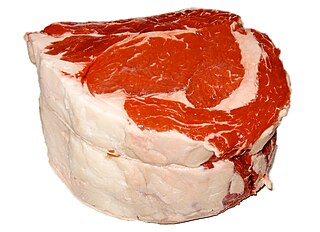Related Research Articles

Beef is the culinary name for meat from cattle. Beef can be prepared in various ways; cuts are often used for steak, which can be cooked to varying degrees of doneness, while trimmings are often ground or minced, as found in most hamburgers. Beef contains protein, iron, and vitamin B12. Along with other kinds of red meat, high consumption is associated with an increased risk of colorectal cancer and coronary heart disease, especially when processed. Beef has a high environmental impact, being a primary driver of deforestation with the highest greenhouse gas emissions of any agricultural product.

Jerky is lean trimmed meat cut into strips and dehydrated to prevent spoilage. Normally, this drying includes the addition of salt to prevent bacteria growth. The word "jerky" derives from the Quechua word ch'arki which means "dried, salted meat".

Advanced meat recovery (AMR) is a slaughterhouse deboning process by which the last traces of skeletal muscle meat are removed from animal bones after the primal cuts have been carved off manually. The machinery used in this process separates meat from bone by scraping, shaving, or pressing the meat from the bone without breaking or grinding the bone. AMR meat typically is used as an ingredient in products requiring further processing, such as hot dogs. Unlike mechanically separated meat, AMR meat is comparable in appearance, texture, and composition to meat trimmings and similar meat products derived by hand.

Mechanically separated meat (MSM), mechanically recovered/reclaimed meat (MRM), or mechanically deboned meat (MDM) is a paste-like meat product produced by forcing pureed or ground beef, pork, mutton, turkey or chicken under high pressure through a sieve or similar device to separate the bone from the edible meat tissue. It is sometimes called white slime as an analog to meat-additive pink slime and to meat extracted by advanced meat recovery systems, both of which are different processes. The process entails pureeing or grinding the carcass left after the manual removal of meat from the bones and then forcing the slurry through a sieve under pressure. This puree includes bone, bone marrow, skin, nerves, blood vessels, and the scraps of meat remaining on the bones.
Ground beef, minced beef or beef mince is beef that has been finely chopped with a knife, meat grinder, mincer or mincing machine. It is used in many recipes including hamburgers, bolognese sauce, meatloaf, meatballs and kofta.

Tyson Foods, Inc. is an American multinational corporation based in Springdale, Arkansas that operates in the food industry. The company is the world's second-largest processor and marketer of chicken, beef, and pork after JBS S.A. It annually exports the largest percentage of beef out of the United States. Together with its subsidiaries, it operates major food brands, including Jimmy Dean, Hillshire Farm, Ball Park, Wright Brand, Aidells, and State Fair. Tyson Foods ranked No. 79 in the 2020 Fortune 500 list of the largest United States corporations by total revenue.

In animal husbandry, a concentrated animal feeding operation (CAFO), as defined by the United States Department of Agriculture (USDA), is an intensive animal feeding operation (AFO) in which over 1,000 animal units are confined for over 45 days a year. An animal unit is the equivalent of 1,000 pounds of "live" animal weight. A thousand animal units equates to 700 dairy cows, 1,000 meat cows, 2,500 pigs weighing more than 55 pounds (25 kg), 10,000 pigs weighing under 55 pounds, 10,000 sheep, 55,000 turkeys, 125,000 chickens, or 82,000 egg laying hens or pullets.

In culinary terms, white meat is meat which is pale in color before and after cooking. In traditional gastronomy, white meat also includes rabbit, the flesh of milk-fed young mammals, and sometimes pork. In ecotrophology and nutritional studies, white meat includes poultry and fish, but excludes all mammal flesh, which is considered red meat.

Chicken is the most common type of poultry in the world. Owing to the relative ease and low cost of raising chickens—in comparison to mammals such as cattle or hogs—chicken meat and chicken eggs have become prevalent in numerous cuisines.

Food safety is used as a scientific method/discipline describing handling, preparation, and storage of food in ways that prevent foodborne illness. The occurrence of two or more cases of a similar illness resulting from the ingestion of a common food is known as a food-borne disease outbreak. This includes a number of routines that should be followed to avoid potential health hazards. In this way, food safety often overlaps with food defense to prevent harm to consumers. The tracks within this line of thought are safety between industry and the market and then between the market and the consumer. In considering industry-to-market practices, food safety considerations include the origins of food including the practices relating to food labeling, food hygiene, food additives and pesticide residues, as well as policies on biotechnology and food and guidelines for the management of governmental import and export inspection and certification systems for foods. In considering market-to-consumer practices, the usual thought is that food ought to be safe in the market and the concern is safe delivery and preparation of the food for the consumer. Food safety, nutrition and food security are closely related. Unhealthy food creates a cycle of disease and malnutrition that affects infants and adults as well.

Intensive animal farming, industrial livestock production, and macro-farms, also known as factory farming, is a type of intensive agriculture, specifically an approach to animal husbandry designed to maximize production while minimizing costs. To achieve this, agribusinesses keep livestock such as cattle, poultry, and fish at high stocking densities, at large scale, and using modern machinery, biotechnology, and global trade. The main products of this industry are meat, milk and eggs for human consumption. There are issues regarding whether intensive animal farming is sustainable in the social long-run given its costs in resources. Analysts also raise issues about its ethics.
Adulteration is a legal offense and when the food fails to meet the legal standards set by the government, it is said to have been Adulterated Food. One form of adulteration is the addition of another substance to a food item in order to increase the quantity of the food item in raw form or prepared form, which results in the loss of the actual quality of the food item. These substances may be either available food items or non-food items. Among meat and meat products some of the items used to adulterate are water or ice, carcasses, or carcasses of animals other than the animal meant to be consumed. In the case of seafood, adulteration may refer to species substitution (mislabeling), which replaces the species identified on the product label with another species, or undisclosed processing methods, in which treatments such as additives, excessive glazing, or short-weighting are not disclosed to the consumer.
In food safety policy, a zero tolerance standard generally means that if a potentially dangerous substance is present in or on a product, that product will be considered adulterated and unfit for human consumption.

Poultry farming is a part of the United States's agricultural economy.
Raw meat generally refers to any type of uncooked muscle tissue of an animal used for food. In the meat production industry, the term ‘meat’ refers specifically to mammalian flesh, while the words ‘poultry’ and ‘seafood’ are used to differentiate between the tissue of birds and aquatic creatures.
Beef Products Inc. (BPI) is an American meat processing company based in Dakota Dunes, South Dakota. Prior to high media visibility of its products, it was a major supplier to fast food chains, groceries and school lunch programs. It had three additional plants, which closed in 2012.

The Food Safety and Inspection Service (FSIS), an agency of the United States Department of Agriculture (USDA), is the public health regulatory agency responsible for ensuring that United States' commercial supply of meat, poultry, and egg products is safe, wholesome, and correctly labeled and packaged. The FSIS draws its authority from the Federal Meat Inspection Act of 1906, the Poultry Products Inspection Act of 1957 and the Egg Products Inspection Act of 1970. The FSIS also acts as a national health department and is responsible for the safety of public food-related establishments as well as business investigation.

Pink slime is a meat by-product used as a food additive to ground beef and beef-based processed meats, as a filler, or to reduce the overall fat content of ground beef. As part of the production process, heat and centrifuges remove the fat from the meat in beef trimmings. The resulting paste, without the fat, is exposed to ammonia gas or citric acid to kill bacteria. In 2001, the United States Department of Agriculture (USDA) approved the product for limited human consumption. The product, when prepared using ammonia gas, is banned for human consumption in the European Union and Canada.

Ground turkey, or minced turkey, is a mixture of dark and light turkey meat with remaining skin and visible fat processed together until a "ground" form emerges. The turkey meat, skin, and fat is taken off the bone and processed with additives. The final product has specific characteristics that appeal to customers, including a non pink color and non crumbly texture. The composition of ground turkey is driven by market demand, availability, and meat prices. The majority of ground turkey is made from excess thighs and drumsticks rather than the more costly breast meat. Ground turkey is a common low-fat alternative for ground beef.
Washing meat or cleaning meat is a technique of preparation, primarily used to treat raw meat or poultry prior to cooking in order to sanitize it. Several methods are used which are not limited to rinsing with running water or soaking in saltwater, vinegar, lemon juice, or other acids, which may also enhance flavor when cooked.
References
 This article incorporates public domain material from Jasper Womach. Report for Congress: Agriculture: A Glossary of Terms, Programs, and Laws, 2005 Edition (PDF). Congressional Research Service.
This article incorporates public domain material from Jasper Womach. Report for Congress: Agriculture: A Glossary of Terms, Programs, and Laws, 2005 Edition (PDF). Congressional Research Service.